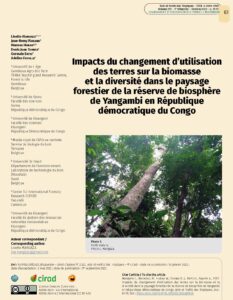
Résumé:
Les forêts tropicales de la République démocratique du Congo sont menacées par la déforestation et la dégradation forestière, qui affectent la structure et la diversité arborée. Cette étude a pour objectif de quantifier les pertes de biomasse et de diversité liées à la déforestation et à la dégradation, en se concentrant sur la réserve de biosphère de Yangambi. Quatre parcelles de 50 m x 50 m ont été inventoriées dans chacun des huit types d’utilisation des terres identifiés : la forêt mature mixte, la forêt mature à Gilbertiodendron dewevrei, les champs des cultures vivrières, les jachères (5 à 10 ans), les forêts secondaires (20 à 40 ans), les plantations de cacaoyers, les plantations de caféiers et les plantations de palmiers à huile. Les stocks de biomasse dans les forêts matures s’élèvent à environ 400 et 380 Mg/ha respectivement pour la forêt à G. dewevrei et la forêt mixte. Les résultats montrent que la forêt mature perd 50, 70 et 90 % de sa biomasse aérienne quand elle est convertie en plantations de cacaoyers, caféiers et palmiers, respectivement, et la quasi-totalité (99 %) lorsqu’elle est convertie en champs de cultures vivrières ; mais quand le champ est abandonné, la biomasse se reconstitue progressivement à 7,5 % après 5 à 10 ans et à 38,8 % après 20 à 40 ans. La diversité est aussi impactée par la conversion, et, bien que la richesse spécifique semble se reconstituer plus rapidement que la biomasse, la composition est fondamentalement modifiée. Ces résultats fournissent des informations essentielles pour quantifier les impacts des solutions « naturelles » pour lutter contre le changement climatique : la protection des forêts matures, l’amélioration de la gestion forestière et le reboisement ; même si l’approche doit être étendue à plus grande échelle.
Abstract:
The tropical forests of the Democratic Republic of Congo are threatened by deforestation and forest degradation, which affect tree structure and diversity. This study aims to quantify biomass and diversity losses resulting from deforestation and degradation, with a focus on the
Yangambi Biosphere Reserve. Inventories were conducted in four 50 m x 50 m plots in each of the eight land-use types identified: mixed mature forest, mature forest with Gilbertiodendron dewevrei, subsistence crop fields, fallows (5 to 10 years), secondary forests (20 to 40 years), and cacao, coffee and oil palm plantations. Biomass stocks in mature forests amounted to ~ 400 and 380 Mg/ha for G. dewevrei and mixed forest respectively. Our results show that mature forests lose 50, 70 and 90%, respectively, of their above-ground biomass when converted to cocoa, coffee and palm plantations, and almost all (99%) when converted to food crops. However, when a crop field is abandoned, above-ground biomass gradually recovers to 7.5% after 5-10 years and to 38.8% after 20-40 years. Conversion also has an impact on diversity, and although species richness appears to recover faster than biomass, its composition is fundamentally altered. Although the approach needs to be scaled up, these results provide essential information for quantifying the impacts of “natural” solutions to climate change, i.e. protection of mature forests, improved forest management and reforestation
Yangambi Biosphere Reserve. Inventories were conducted in four 50 m x 50 m plots in each of the eight land-use types identified: mixed mature forest, mature forest with Gilbertiodendron dewevrei, subsistence crop fields, fallows (5 to 10 years), secondary forests (20 to 40 years), and cacao, coffee and oil palm plantations. Biomass stocks in mature forests amounted to ~ 400 and 380 Mg/ha for G. dewevrei and mixed forest respectively. Our results show that mature forests lose 50, 70 and 90%, respectively, of their above-ground biomass when converted to cocoa, coffee and palm plantations, and almost all (99%) when converted to food crops. However, when a crop field is abandoned, above-ground biomass gradually recovers to 7.5% after 5-10 years and to 38.8% after 20-40 years. Conversion also has an impact on diversity, and although species richness appears to recover faster than biomass, its composition is fundamentally altered. Although the approach needs to be scaled up, these results provide essential information for quantifying the impacts of “natural” solutions to climate change, i.e. protection of mature forests, improved forest management and reforestation
Consultez la notice complète de l’article sur ORBi
